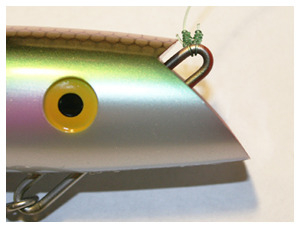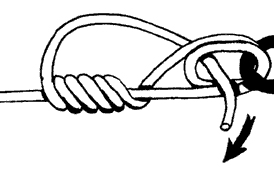When trolling your Tomic Plug, it is very important to place the knot as far back and centered on tow bar as possible.

Notice in the photo one little trick of ours is to have a second knot in place below the knot to the line you’re using (it’s just a knot that’s trimmed off there). This knot below acts like a bumper, helping to keep the line as high up on the tow bar as possible. We suggest just leaving that bumper knot in place between uses.
Having your knot positioned high up on the tow bar will give your plug the correct side to side swimming action. For the best action tie directly to the tow bar as shown. Some fishermen like to tow from a welded ring in the nose (see nose rings) for a different action.
Tuning: when you start to fish, have a look at your plug when it’s in the water. The action should be an even side to side motion. If the plug keeps tracking to one side, push the knot in the direction you want the plug to track to correct the action.
Speed: An even side-to-side swimming action is best. The plug or spoon should not roll and if it does roll, it’s going too fast. It’s generally believed that plugs or spoons work best when trolled faster than you might troll when bait fishing. They’ll still work at a slow troll, but they’ll work better going faster (2.5 to 5 mph). If you’re trolling with the current, you’ll be going faster to get the right action, then when you turn around against the current, you’ll be trolling slower. If you’re using a downrigger the angle of the downrigger line is what you should note. Often a 45 degree angle is a good speed to aim for. Do note the angle of your downrigger line when you get a strike so you can aim for that speed again. If you’re using steel cable for downrigger line, it should be “singing”. Faster is generally better as long as the plug is not rolling over. If you’re familiar with salmon – they can swim really fast – so they have no trouble catching a fast lure. With a fast lure, we believe the fish is more likely to act on instinct and strike, but if the lure is ambling by, the fish won’t feel the urgency to catch it while he can.
Note if you do want to troll really fast (perhaps for tuna) and your plug is rolling over, you can change the hook to a bigger one, and that will act like a keel to allow for faster troll speed.
Leader: Plugs are like a dog on a leash – for the most action have a long leader. Lighter, thinner, mainline will also allow for more plug action as there’s less resistance. Leader length is just one of those variables you need to play with each day to see just what the fish are in the mood for. If you’re not using a flasher so the lure doesn’t need to be close to that, and there’s not much traffic, sometimes a very long leader (like 60 or 80 feet) will work when fish are skittish and won’t come close to the boat. When using a flasher though, the plug needs to be close to the flasher or it’s not doing any good – so perhaps 3 to 8 feet from the flasher.
Flasher: You DO NOT NEED a flasher, all our lures have plenty of action without a flasher. They may be used with a flasher, if that’s how you like to fish – but the flasher is not required to give the lure action. Our favorite way is to use a dummy flasher when downrigging, so the flasher is attached to the downrigger ball and not in line with the lure. You get the attracting power of the flasher, but the flasher is not between you and the fish when the fish is on. More detail on dummy flashers here.

The Trilene knot is a good one, but any firm knot will do if you’ve got another favorite.
Notice for the Trilene knot that the leader is threaded through tow bar twice. While holding both loops, proceed as regular cinch knot, use 5-10 wraps. To tighten, pull tag end snug while sliding knot with thumb and forefinger. Repeat this until a tight knot is achieved on pin. This will ensure the knot won’t slip from position.
These instructions are the tried and true standard instructions for plug fishing. There have been lots of modifications, adjustments and alterations made over the years. If you’ve discovered a new way of fishing with your Tomic we’d like to hear from you. Good luck fishing!
Links to more Instructions:
Lures for Action or Attraction